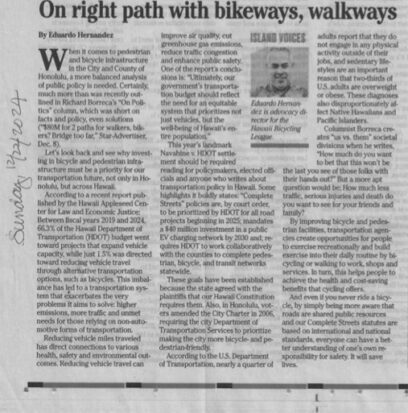
12/22/2024
When it comes to pedestrian and cycling infrastructure in the City and County of Honolulu, a more balanced analysis of public policy is needed. Certainly, much more than was recently outlined in Richard Borreca’s “On Politics” column, which was short on facts, policy, even solutions. ($80M for 2 paths for walkers, bikers? Bridge too far,” Star-Advertiser, Dec. 8).
Let’s look back and see why investing in bicycle and pedestrian infrastructure must be a priority for our transportation future, not only in Honolulu, but across Hawai‘i.
According to a recent report published by the Hawai‘i Appleseed Center for Law and Economic Justice, between FY19 and FY24, 66.3 percent of the Hawaii Department of Transportation (HDOT) budget went toward projects that expand vehicle capacity, while just 1.5% was directed towards reducing vehicle travel through alternative transportation options, like bicycles. This imbalance has led to a transportation system that exacerbates the very problems it aims to solve—higher emissions, more traffic, and unmet needs for those relying on non-automotive forms of transportation.
Reducing vehicle miles traveled has direct connections to various health, safety and environmental outcomes. Reducing vehicle travel can improve air quality, cut greenhouse gas emissions, reduce traffic congestion, and enhance public safety. One of the report’s conclusions is: “Ultimately, our government’s transportation budget should reflect the need for an equitable system that prioritizes not just vehicles, but the well-being of Hawai‘i’s entire population.”
This year’s landmark Navahine v. HDOT settlement should be required reading for policymakers, elected officials, and anyone who writes about transportation policy in Hawai‘i. Some highlights it boldly states: “Complete Streets” policies are, by court order, to be prioritized by HDOT for all road projects beginning in 2025; mandates a $40 million investment in a public EV charging network by 2030 and; requires HDOT to work collaboratively with the counties to complete pedestrian, bicycle, and transit networks statewide. These goals have been established because the State agreed with the plaintiffs that our Constitution requires them. Also, in Honolulu, voters amended the City Charter in 2006, requiring DTS to prioritize making the city more bicycle and pedestrian friendly.
According to the U.S. Department of Transportation, almost a quarter of adults report that they do not engage in any physical activity outside of their jobs, and sedentary lifestyles are an important reason that two-thirds of U.S. adults are overweight or obese. These diagnoses also disproportionately affect Native Hawaiians and Pacific Islanders.
Columnist Borreca creates Us v. Them societal divisions when he writes: “How much do you want to bet that this won’t be the last you see of those folks with their hands out?” A more apt question would be: How much less traffic, serious injuries, and death do you want to see for your friends and family?
By improving bicycle and pedestrian facilities, transportation agencies create opportunities for people to exercise recreationally and build exercise into their daily routine by bicycling or walking to work, shops, and services. In turn, this helps people to achieve the health and cost saving benefits that cycling offers.
And even if you never ride a bicycle, simply being more aware that roads are shared public resources and our Complete Streets statutes are based on international and national standards, everyone can have a better understanding of your own responsibility for safety. It will save lives.

